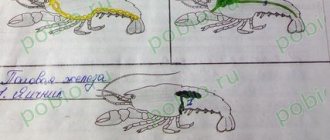What is human memory? The concept of memory as a psychological process. Mnemonic processes. Types of mnemonic processes. Recognition, memorization, reproduction. Theories of memory: associative, gestalt, behaviorism and semantic theories of memory. The inner world of a person consists of many emotional and psychological components, due to the high level of mental development. The constant development of the psyche and its components is ensured by the accumulation of experience, knowledge and skills in the process of life, i.e. Every moment, impression, emotion, experience or vivid impression leaves its mark.
All experienced emotions, both positive and negative, are stored in a person’s memory for a very long time and determine further actions, manifest themselves in the form of behavioral guidelines and then become the subject of consciousness. So what is memory, what does it consist of and how do its basic mechanisms operate?
What is human memory in psychology
The concept of memory can be characterized as the imprinting or storing of received information, subsequent recognition of what was seen (heard), and further reproduction of past experience .
Thanks to memory, a person has the opportunity to accumulate experience and skills, learn and constantly learn new things, and improve.
Memory consists of constantly occurring mnemonic processes , which consist in the fact that we see and recognize and remember an object that we have already seen and or touched.
Types of mnemonic processes
There are different types of mnemonic processes. For example, a seen object, object or some phenomenon seems already familiar to us. Such processes are called recognition .
Also, the human psyche can reproduce in memory images of objects that we once saw, but are not observed at the moment. This mnemonic process is called image reconstruction or reproduction .
It is necessary to understand that not only real objects can be reproduced, but also feelings, emotions, experiences, both negative and positive.
In order for there to be a process of reproduction, it must be preceded by imprinting or memorization , which will lead to the preservation of the image.
Thus, we can conclude that memory consists of complex mechanisms connected with each other and moving from one to another.
Memory is necessary for a person; it is it that allows one to develop and improve over time.
Today, the science of psychology is seeking answers to questions related to the study of all the tiny details of memory processes, mechanisms of imprinting, accompanying physiological reactions, and most importantly, what is still unknown to humanity is the maximum limits of human memory and the possibilities of expansion. All these are complex tasks that require answers for further improvement and development in the future.
In addition, psychologists daily try to unravel the mysteries and come to “a common denominator” in matters of time limitations for storing images, and the conditions and prerequisites for this, as well as changes in memory that occur in a hidden or latent state of memory. But the most important thing is how exactly these changes affect a person, how they affect the knowledge of the processes of the surrounding world.
Class hour on the topic “Memory”
Psychological class hour “Memory training”
Class hour epigraph:
“A person needs memory for all manifestations of the soul”
Blaise Pascal.
Target:
show students different ways to train their memory; explain the need for memory development for successful learning at school.
Lesson form:
combined (workshop and conversation).
Progress of the lesson.
1. Introductory part.
Our class hour is dedicated to memory. I want to hear your opinions: What is memory? (children's answers).
Every day we learn something new. Everything that a person learns is stored in memory. “Memory is the storehouse of the mind,” said Suvorov.
Memory
– a mental property of a person, the ability to accumulate, store and use information. Without memory, people would not be able to pass on their accumulated experience from generation to generation. Humanity could not develop.
Memory can be motor, visual, auditory, verbal
.
Imagine: there is a lesson and the teacher explains a new topic. We hear the teacher's voice - auditory memory works, we write words in a notebook - motor, visual and verbal memory works. When all types of memory are working, we will remember 16 words out of 20, when we only listen, we will remember only 5 words. Now you understand why the teacher requires you to listen and write down his explanations. This way, 3 times more information is remembered.
Memorization can be meaningful and mechanical. Once you understand a rule, it's easy to learn—it's meaningful memorization. And when you don’t understand, you have to memorize mechanically. Everyone knows how long and hard it is.
We remember the multiplication table for a long time - this is long-term memory, but yesterday's TV series can be forgotten today - this is short-term memory. When we remember, we associate it with what is already in our memory. Therefore, the more a person knows, the more connections he can make, the easier it is for him to remember something new.
It becomes clear why teachers advise us to read more. A person can store a huge amount of information in memory storage rooms. According to scientists, each of us is able to remember millions of books. But because of laziness or ignorance, we use only a small part of our brain. Some historical figures had amazing memories. For example, Alexander the Great and Julius Caesar knew by sight and name all their soldiers, and there were over 30 thousand of them each. Napoleon had the same abilities. All these great people worked hard on their memory, developed it and achieved incredible success. They were helped in this by memorization techniques that have been known since ancient times. This means that memory, like muscles, needs to be trained, otherwise “the brain will rust,” as psychologists say.
Memory theory
Since ancient times, humanity has wondered what human memory is and the direct psychological connections between memorizing and reproducing information. Explaining these mechanisms, many theories and explanations have emerged, which vary and are characterized by certain principles, for example:
- Aristotle's associative theory;
- Gestalt theory;
- Behavioral theory;
- Semantic theory of memory.
Only by considering each theory separately can one determine its features.
Aristotle's association theory
Assumes that all memorization consists of creating connections – associations. There are some types of associations:
- Association by contiguity , which lies in the fact that by reproducing images, a person’s memory also reproduces the emotions that were experienced in those moments, both negative and positive.
- Association by similarity , which is ensured by the reproduction of images and all features that are similar to it. For example, when you see a photograph of a person, ideas about him (character, voice timbre, etc.) immediately arise.
- Association by contrast consists of representational processes that are based on contrast, on features opposite to the image.
Gestalt theories
Over time, one theory gave way to another, and now the time has come for the Gestalt theory, the essence of which was completely opposite. The theory was determined not by partial associative elements, but by a full-fledged holistic organization of processes - gestalt . The direction of studying such a theory began to be called Gestaltology , the main postulate of which is the presence of the whole, the totality of all mechanisms, systems and functions of memory that form representation and perception.
Behavioral theory
The theory of behaviorism, which replaced the “Gestalts,” was in many ways similar to the previously presented theory of associations, with only one significant difference - according to the theory of behaviorism, the memorization process had to be constantly reinforced by some kind of stimulus for high-quality further reproduction.
Semantic theory of memory
The beginning of the twentieth century in psychology was marked by the emergence of a new semantic theory of memory, the meaning of which was that all processes and accompanying reactions proceed in direct proportion to the presence or absence of a semantic connection that unites them. Thus, the theory that memory processes are inextricably dependent on thinking processes was subject to proof. Thus, memory, as a meaningful human activity, depends on the task at hand. It has also been proven that actions, as opposed to thoughts, are much better remembered.
Recent studies have proven that all memory processes are associated with biochemical reactions and RNA modifications.
In addition, recently scientists have been trying to prove and study certain areas of the brain responsible for storing and reproducing information, as well as characterizing the processes of forgetting. But more on that in other articles.
Effects and phenomena of memory
The phenomenon of reminiscence is specially highlighted - this is delayed involuntary reproduction. Reminiscence means that the reproduction of memorized material does not deteriorate over time, but, on the contrary, improves. This is related to the awareness of information (poorly understood information becomes conscious over time). Reminiscence depends on the quality of preliminary training. Most often it occurs when memorizing a large amount of material. Experiments have shown that this phenomenon is more common in children than in adults.
2) If the subject is offered a series of stimuli for learning, and then asked to reproduce these stimuli in random order, then the probability of reproducing the first and last stimuli will be higher than the stimuli located in the middle of the series. This phenomenon is called the “primacy and recency effect .
3) Bluma Vulfovna Zeigarnik, Soviet psychologist, founder of Soviet pathopsychology, discovered a memory effect called the Zeigarnik effect.
The Zeigarnik effect implies that an unfinished gestalt—an interrupted action—is remembered better. If people are given a series of tasks and allowed to complete some of them, while others are interrupted unfinished, then it turns out that subsequently the subjects are almost twice as likely to remember unfinished tasks than those completed at the time of interruption. This is explained by the fact that when receiving a task, the subject has a need to complete it, which intensifies in the process of completing the task. This need is fully realized when the task is completed, and remains unsatisfied if it is not completed. Due to the connection between motivation and memory, the former influences the selectivity of memory, retaining traces of unfinished tasks in it.
4) In 1885, the German scientist G. Ebbinghaus discovered the forgetting curve , which shows how much of what a person remembers at different intervals of time.
To conduct the experiment, he came up with lists of pseudowords formed by two consonants and one vowel (ZAC, BOK, SID). After learning several lists, he tested how many words from each list would be recalled after 20 minutes, 1 hour, 7–9 hours, 1, 2, 6, and 31 days. In the first hours, the amount of information learned quickly drops and after 10 hours it is only 35% of what has been learned. Further, the process of forgetting proceeds slowly and after 6 days 20% of the total number of initially learned syllables remains in memory, and the same amount remains after a month.
Ebbinghaus called the value additional to the number of correctly reproduced words the forgetting index and constructed the famous forgetting curve, which could be called the reproduction curve.



